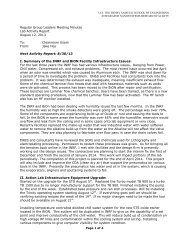Download Lab Safety Manual - Integrated Nanosystems Research ...
Download Lab Safety Manual - Integrated Nanosystems Research ...
Download Lab Safety Manual - Integrated Nanosystems Research ...
You also want an ePaper? Increase the reach of your titles
YUMPU automatically turns print PDFs into web optimized ePapers that Google loves.
wearers must use standard safety glasses when working in the lab, and full face shields in addition to safety<br />
glasses when working at chemical wet benches.<br />
2.4 Protective Gear<br />
While operating certain stations, additional protective wear will be required. Use of any wet benches or the<br />
normal handling or transportation of any chemicals in the lab requires the use of protective chemical wear.<br />
See the SOP and the chemical handling procedures in the appendices for specific details. Certain process and<br />
maintenance functions may require additional gears, such as respirators; however, researchers should not be<br />
required or asked to perform such functions.<br />
2.5 Buddy System<br />
For safety reasons, a user is not allowed to work in the lab alone at any time when using hazardous material.<br />
Because the lab runs 24/7, there may be occasions (such as a late night, over a long holiday or weekend) when<br />
you plan to work during a time when there is no staff. However, you may only access the lab as a super user<br />
and do limited research. If you are not a super user you must plan ahead and coordinate your work schedule<br />
with staff or a super user. In all cases, you must inform staff if you plan to use the INRF/BiON facilities during<br />
off hours.<br />
2.6 Special Health Considerations<br />
• Pacemakers<br />
Equipment in the lab may serve as sources of ionizing radiation, ultrasonic interference or electromagnetic<br />
interference, which may affect normal operation of a pacemaker. If you have such a device, you should consult<br />
your physician before embarking on work in the lab.<br />
• Reproductive Health<br />
Users who express a concern about their reproductive health potentially being affected by the work area should<br />
notify their supervisor and the INRF/BiON <strong>Safety</strong> Officer and EH&S to initiate a worksite evaluation.<br />
• Chemical and Latex Allergies<br />
The trace presence of certain chemical compounds in the lab may trigger allergies in certain sensitive individuals.<br />
The most common chemical sensitivity encountered is that to latex, found in the clean room gloves. Nitrile<br />
cleanroom gloves are provided and may be used in place of latex, by sensitive individuals. There may be other<br />
trace chemicals present in the lab, which may also trigger allergies, Learn to recognize the signs of contact allergic<br />
reaction (skin sensitivity, hives, wheezing) and act to identify and avoid future contact.<br />
3. <strong>Lab</strong>oratory Hazards Overview<br />
3.1 Chemical Hazards<br />
Every chemical is hazardous, even water, it depends on dose. We handle hazardous chemicals in our every day<br />
lives, from pumping gasoline to using chlorine bleach. The keys to safe use of these and any chemical are:<br />
understanding the hazards presented by each specific chemical; knowing and using the appropriate precautionary<br />
measures to minimize these hazards.<br />
Despite the many hazardous chemicals present in the lab, the INRF/BiON has a good safety record. However,<br />
because of this, it is also easy to become complacent and treat hazardous materials casually. The importance of<br />
precautionary measures cannot be emphasized enough. Simple precautions can be a lifesaver; use them as you<br />
would a safety belt in a car.<br />
7



